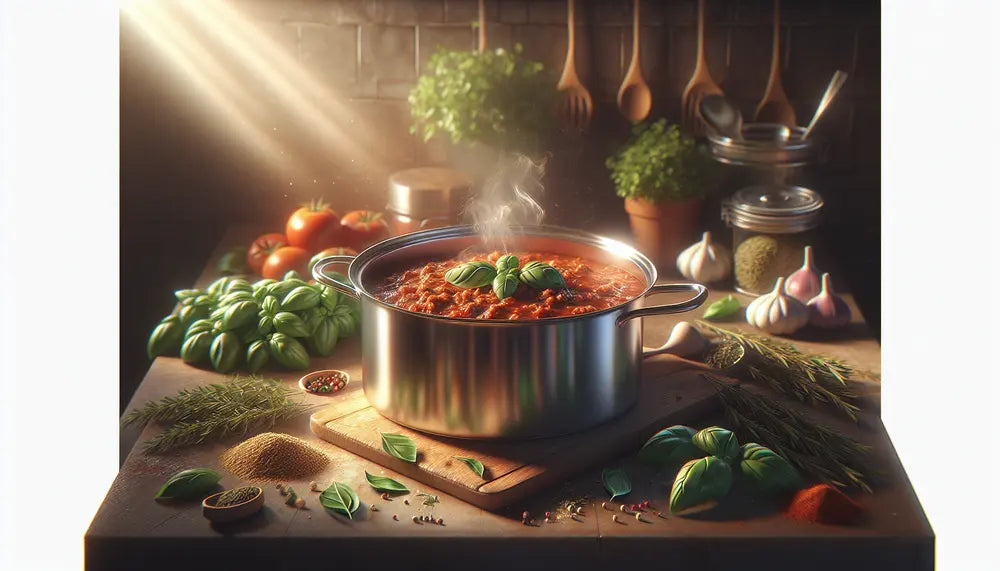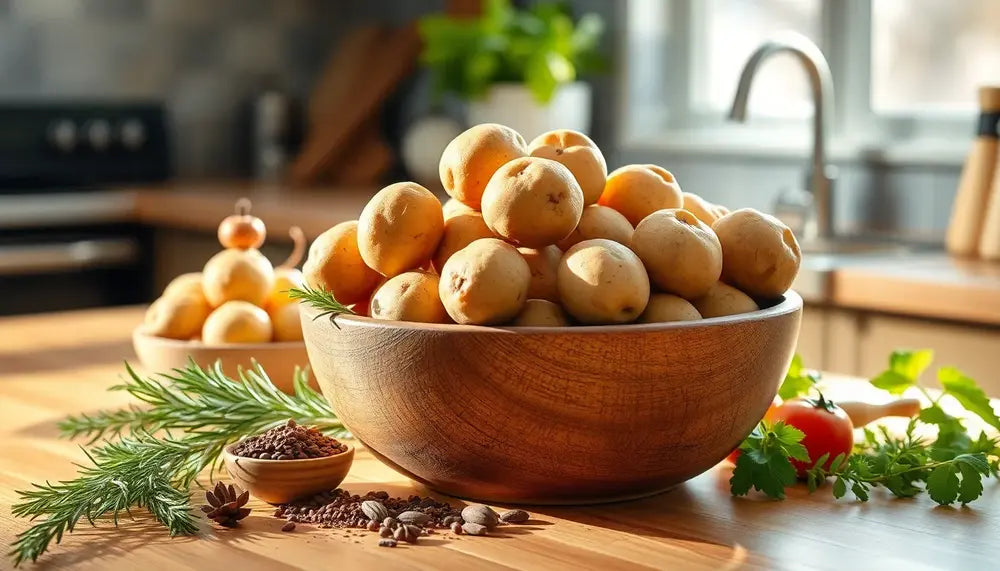The basics: Which spices belong in Bolognese
Understand which ones spices essential for the preparation of a classic Bolognese, forms the basis for a successful dish. A traditional Bolognese sauce is characterized by a harmonious mix of different flavors, which is mainly achieved through the targeted use of spices. The most commonly used seasonings in a classic Bolognese include salt, black pepper, and often nutmeg, which adds a subtle, warm note.
Additionally, bay leaves can be added during cooking to add a savory depth. A little sugar or a dash of red wine adds a touch of sweetness and complexity. A pinch of oregano or Italian herb mixtures bring the typical Mediterranean aroma that many associate with Bolognese. However, it is important to use these spices in the right amount to maintain the balance of flavors and not overpower them.
Basically, the choice of seasoning should be based on Quality and Freshness Be careful, as this directly influences the flavor intensity and thus the end result. Freshly ground pepper, for example, offers a fuller flavor than pre-ground versions. By understanding and applying these basics, you lay the most important foundation for a delicious and authentic Bolognese.
Choosing the right spices for an authentic Bolognese
Choosing the right seasonings is crucial to giving your bolognese an authentic Italian character. In addition to the basic spices, there are special ingredients that help further refine the flavor and stand out from the standard.
Garlic and onions, for example, are essential for creating a strong flavor base. They should be fried in olive oil at the beginning of the cooking process so that their flavors can fully develop. Marjoram and basil are other herbs that are often used in Bolognese and enrich the sauce with a fresh and sweet note.
A small amount of paprika or cayenne pepper can be added for a slightly spicy and smoky note. However, these should be used sparingly so as not to overpower the taste of the other spices. A touch of thyme can also round off the aroma, providing a slightly bitter note that harmonizes particularly well with the meat.
The spices and their specific uses can be clearly presented in a table:
| Spice | Area of application | Effect |
|---|---|---|
| Garlic | Fry at the beginning | Strong aroma |
| Marjoram | Add just before the end | Sweet and fresh |
| Basil | Add just before the end | Sweet freshness |
| Paprika powder | Add when frying | Spicy and smoky |
| Thyme | While cooking | Tart and aromatic |
This all supports the goal of... authentic and to create aromatic Bolognese that inspires.
Dosage and timing: When and how much seasoning to add
Proper dosage and timing when adding seasonings are crucial to unlocking the full potential of the flavors in your bolognese. Every spice has its ideal time at which it should be added to the sauce in order to develop its full effect.
Based on the intense flavors, it is advisable to start with the stronger spices. For example, nutmeg and pepper are added while the meat is browning, as the heat helps to release their full aroma. Garlic and onions are typically sautéed in oil to begin with to create a flavor base.
The finer herbs such as basil and marjoram should only be added towards the end of the cooking time. Their flavors are more volatile and can be lost if cooked for too long. The rule here is that less is usually more. A rule of thumb for dosage could look like this:
- Nutmeg: a quarter teaspoon
- Pepper: to taste, but start with half a teaspoon
- Basil: a handful of fresh leaves, added just before serving
- Marjoram: a teaspoon dried or a tablespoon fresh
This information is intended as a guide and should be adjusted based on personal preference and the amount of sauce. The quality of the spices also plays a role: fresher products can taste more intense and may require the quantity to be adjusted.
The correct timing and the correct dosage of spices ensure that every portion of Bolognese is a taste experience. Each individual spice contributes its part to the harmonious overall picture if it strategic and targeted is used.
Experimenting with spices: Variations on the classic Bolognese
A little creativity in the kitchen can take classic dishes like bolognese to a whole new dimension. Experimenting with different spices offers the opportunity to transform traditional Bolognese into an individual taste experience and to express yourself culinary.
For example, you can expand the traditional aroma profile with Mediterranean herbs or create completely new flavors by integrating exotic spices. For example, cumin and cardamom can add an oriental note, while chipotle or smoked paprika give the bolognese a smoky, spicy component.
To illustrate how you can experiment with spices, here are some suggestions:
- Add a pinch of cinnamon, for a sweet and spicy note.
- Turmeric for a slightly earthy note and an attractive color.
- Ras el Hanout, a North African spice mixture, creates a complex aroma.
- Harissa paste for heat and a strong seasoning, ideal for lovers of spicy dishes.
These spices should be added in small quantities at a time, and it is advisable to taste the dish several times during cooking. The dosage of the spices can be adjusted according to personal preference or the required intensity:
| Spice | quantity | Effect |
|---|---|---|
| Cinnamon | ¼ teaspoon | Sweet and spicy |
| Turmeric | ½ teaspoon | Earthy note |
| Ras el Hanout | 1 teaspoon | Complex and aromatic |
| Harissa paste | 1 tablespoon | Hot and spicy |
The special thing about experimental cuisine is that it constantly offers room for new discoveries. This is how the traditional dish can be made again and again reinterpreted and served in an exciting way.
The role of fresh herbs in your Bolognese
Fresh herbs play a central role in the preparation of an aromatic Bolognese. They not only bring color and freshness to the dish, but also a variety of flavor nuances that can significantly influence the final result.
Compared to dried herbs, fresh herbs offer a more intense aroma. Parsley, rosemary and thyme are classic examples that are often used in Italian cuisine and develop their flavors particularly well in warm sauces. They should be added toward the end of cooking to preserve their freshness and color while releasing their full flavor.
Here is an overview of some popular fresh herbs and their use in Bolognese:
- Parsley – It is often added as a final step and provides a light, refreshing note.
- rosemary – A robust herb that offers a woody depth. A small sprig while cooking can go a long way.
- Thyme – With its distinctive taste, it supports the earthiness of the dish without dominating.
Incorporating fresh herbs gives your Bolognese a dimension of flavor and freshness that is difficult to achieve with dried herbs. Fresh herbs should always be cleaned and properly prepared before adding them to the dish to get the most out of their natural essence.
It is also recommended to have fresh herbs in one moderate Measurements to be used as their flavors are clear more present than their dried counterparts. A small amount used at the right time can significantly enhance the taste of your sauce without overpowering it.
Here's how to store spices properly to protect their flavors
Proper storage of spices is crucial to preserving their flavors and freshness. Light, heat and moisture are the main enemies of spices and can cause them to quickly lose their flavor.
Spices should always be included airtight Stored in containers to protect them from moisture and other environmental influences. Dark glass containers or metal cans are particularly suitable for this because they shield light, which can break down the chemical structures of the spices and thus reduce their aroma.
The storage location also plays an important role. Spices should not stored above the stove or in the immediate vicinity of heat sources. A cool, dry, dark environment, such as a cupboard or drawer away from heat sources, will help maximize the life and potency of the spices. Here are some practical tips for storing spices:
- Avoid storing spices on open shelves near kitchen appliances that generate heat.
- Store the spices in containers with tight-fitting lids to prevent moisture from entering.
- Label seasoning containers with the purchase or opening date to keep track and replace old inventory in a timely manner.
The right storage conditions delay the natural decomposition of the aromatic substances. Ideally, the storage temperature should be kept constantly below 20°C and the humidity should not exceed 60%. The stability of spice flavors can be illustrated by the following formula:
\[ \text{Stability} = \frac{1}{\text{light} + \text{heat\heat} + \text{humidity}} \]
These simple steps help to ensure the quality of your spices in the long term and guarantee that your dishes always impress with full-bodied flavors.
Conclusion: Why the right seasoning makes the difference
The right seasoning of a Bolognese can have a decisive influence on the final result of the dish. Each spice brings its own nuance and can have a profound effect on the flavor of the sauce. By cleverly combining and dosing spices, a depth of flavor is achieved that elevates the dish from a simple meat sauce to a culinary experience.
Knowing when to add a seasoning plays a crucial role in the end result. While some spices are most effective when added early, others, especially fresh herbs, are best added near the end of cooking to preserve their fresh and full flavors.
Experimenting with different spices and adapting to regional or personal taste preferences can turn a traditional Bolognese into a very personal creation. Maintaining a balance between traditional elements and your own ideas about taste illustrates the creative potential that cooking brings with it.
In addition, storing the spices properly ensures that their aroma and flavor components are preserved, which in turn contributes to a higher quality of the final dish. Careful storage in appropriate conditions ensures that the spices' maximum potential is available at all times.
In conclusion, it can be said that care and knowledge of the right spices and their use in the kitchen plays an essential role when it comes to creating authentic and flavorful dishes. Whether it is a simple meal or a feast, the proper seasoning definitely does that Difference.
FAQ: Insider tips for a masterful Bolognese
Which spices are essential for an authentic Bolognese?
In addition to salt and pepper, garlic, nutmeg, bay leaves and Italian herbs such as oregano and basil are essential for a real Bolognese. These spices help to achieve and intensify the typical aroma.
When should spices be added to bolognese?
Spices like garlic and onions should be sauteed early in the cooking process. Herbs like basil and oregano are ideally added towards the end to preserve their fresh taste.
How can you vary the taste of a traditional Bolognese?
A traditional Bolognese can be reinterpreted by adding exotic spices such as cumin or cardamom. You can also experiment with different types of wine to change the flavor.
How important is the quality of the spices to the final result of the Bolognese?
High quality and freshness of the spices are crucial to achieve an intense and harmonious taste. Freshly ground spices generally offer a fuller flavor than pre-ground spices.
How can spices be optimally stored to protect their aromas?
Spices should be stored in airtight, opaque containers in a cool, dry place. They should also be kept away from heat sources to minimize loss of flavors.





Share:
The perfect spices for homemade sauerkraut
The ultimate spice list: must-haves for the kitchen